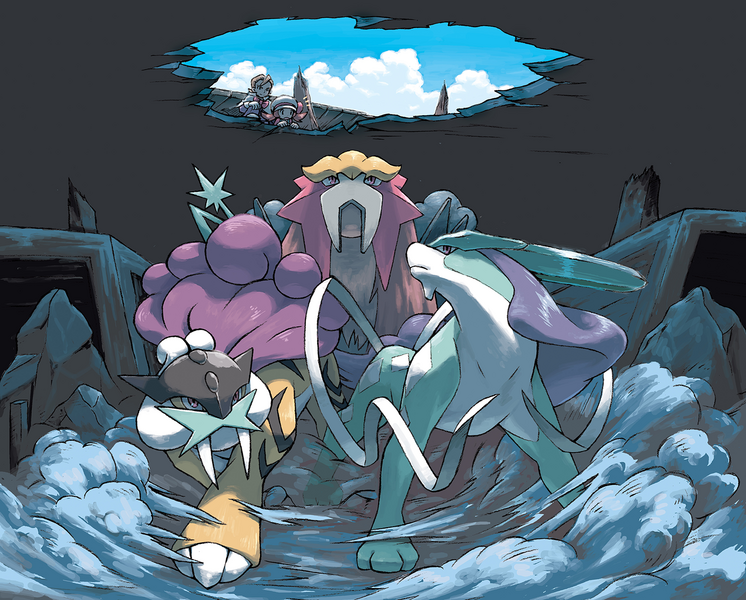
Sparkledogs ahoy! Go to any good fansite and they will tell you how to get these shiny, shiny critters. Raikou's going to be appearing at your local GameStop from Jan 3-9; Entei from Jan 17th-23rd; Suicune from Jan 31st to Feb 6th.
Ever since Pokemon Gold, Silver, and Crystal came out, there has been a huge debate over whether the Legendary Trio of Gen II - Raikou, Entei, and Suicune - are cats or dogs. This is probably because these two are the only carnivorous groups that many people formally recognize. (What if they're procyonids, related to aardwolves, synapsids or the last remaining carnivorous marsupials? Ever think of that?) This debate has led to them jokingly being called the "Legendary Hamsters."
Even Nintendo has no firm say on this one; although the old official player's guide outright calls Entei a cat, the recent Pokemon TCG tins have doglike adages attached to them ("every Pokemon has its day" and "every tin is a trainer's best friend"). If they had a stance, they've either forgotten it or are preying on the rift in the fanbase.
The Legendary Beasts have been causing confusion since G/S first came out. They should not be; their lineage is obvious enough if you can see oriental mythology beyond the dragon. The Beasts are both cats and dogs while also being neither. Yes, really:
You have probably seen this creature somewhere before. It might have been at a Chinese restaurant, a home deco store, or even in front of a classy hotel. They usually travel in male-female pairs, looking majestic and intimidating regardless of what sex you are staring into the mouth of. They are so common in Eastern decor that many people just shrug them off as dogs, even though they are an entirely different creature.
The (catchable) Legendary Pokemon of Johto all derive from oriental mythology: Although Lugia looks more like a sea slug than a dragon, its contrast with Ho-oh and overall position in the lore of the Pokemon world say that it should be a ryuujin (lit. "dragon god"), a kingly serpent of the ocean; Ho-oh is, a bit more obviously, a houou, the Japanese version of China's multicolored fenghuang. Logically and aesthetically, the Beasts should also fit with some oriental motif.
(Much thanks to Google Image Search and Bulbapedia for the six pics used. No animals were harmed in the making of this image, but some people might find their souls broken.)
They do. They all resemble, in some way, shape or form, the Chinese Fu Dogs (a misnomer), guardian lion-dogs, shisa, shishi, shizi, Tibetan snow lions, or whatever else you would like to call them. Although varying slightly by area, the basic function of an Asian lion is to ward off evil. Stationary shishi are usually placed alongside doorways; dancing lions (also called shishi) chase away evil spirits more actively. Shishi statues can be found outside of shrines and homes in Japan, Korea and China. Although they look like dogs to most Westerners, they are supposed to be lions.
China does not have wild lions. They have tigers, leopards, and pandas that should have been Darwinized out of the system ages ago, but they do not have lions. The tiger is the king of beasts over there, expressed both by one of the most masculine signs in the Zodiac and the "king" character derived from the tiger's forehead marking (pronounced "wahng," not "wayng" - stop laughing). The ruler of beasts, even in mythology, is either the tiger or a creature called a qilin. For the longest time, the Chinese did not have a clue what a lion really looked like...so they made one.
There is a story that a monk first heard of apotropaic lions in a spiritual vision, but did not know what they looked like. Being told that it was the real king of beasts, he took all the magical or lucky animals he could think of and made a 'lion.' That mishmash included dogs, which were afterwards bred to look even more like 'lions.' Real lion pelts were also probably thrown into the mix, but that's as far as the similarities go.

Get in the car?
Chinese lions have different rules from real lions. The sexes of lions used in lion dances are not distinguishable by mane or size. The sexes of stationary shishi can be distinguished depending on what the beast has beneath its paw (the female has a cub, the male has a sphere) and, in Okinawa, by whether the mouth is open or closed. You will find things like "the female has her mouth closed, as she should" or "the male has his mouth closed to keep the luck in." Sexing does not matter for the Legendary Beasts; the point is that, like Ho-Oh and Lugia, they are just barely based off of real animals. Lions are mythical in China.

Why three of them, then? Although stationary shishi usually come in pairs, the dancing lions can often be divided into threes (or fives). The most common colors are golden/yellow, red, and black/green - in that order. (Sometimes, the other two elements -there are five total elements in Chinese mysticism - are added in other ordering systems.)
This should sound familiar. Although Articuno, Zapdos, and Moltres follow the same elemental/color pattern as the Eeveelutions (Water/Ice/Blue, Electric/Yellow, Fire/Red), the Beasts follow the traditional order of shishi, with yellow coming first (then red, then green/black). These colors have different stories and meanings, but it is widely thought that the black lion is the youngest - and, therefore, comes last in line (but first when dancers are starting out).
The order seen in the Legendary Beasts - yellow, red, blue - is common in lion dancing. The golden lion represents either liveliness or the warrior-emperor Liu Bei, the oldest of three 'brothers' from Romance of the Three Kingdoms; the red lion, courage or Guan Gong AKA Guan Yu, the middle brother; the black lion, friendship or Zhang Fei, the youngest brother. (The element of water can be represented with black in feng shui.) If the new cave Legends are the Three Musketeers, Romance of the Three Kingdoms is fair game. Everything weird about the Legendary Beasts makes sense in the context of Chinese lions.
 |
| But they didn't even start the fire... |
Arcanine is a more obvious tribute to shishi (or Okinawan shisa) than the Legendary Beasts. There are hints that, like Ho-Oh and Lugia, it was designed to be a Legendary Pokemon. (The most obvious of these is in its species designation as "Legendary," but there is also one bit in the first episode of Pokemon ever: Arcanine is pegged as a Legendary alongside Articuno, Zapdos, and Moltres at a Pokemon Center.) It, like Lugia and Ho-Oh, was based off of a mythical creature from oriental folklore. (This is why Arcanine is called "Chinese" on the HG/SS trading card.) Instead, it was made into an evolution of Growlithe, the Puppy Pokemon; the Legendary Beasts stole its thunder in Generation II. Arcanine did not retain its Legendary status, but the ambiguity is still there.
After Arcanine was axed from Club Legendary, three new members with a similar basis took its place in Generation II. The new shishi, Raikou, Entei and Suicune, formed a trio that contrasted with the Legendary Birds in Generation I. They, like Arcanine, had both feline and canine in their blood. Despite having "canine" right in the name, it is obvious that Arcanine has some catty characteristics as well (such as the coat). People are not afraid to admit that Arcanine has traits of both cats and dogs; why so split with the Beasts?
The three Legendary Beasts are lions based on dogs based on lions. It is just as silly to debate over whether the Beasts are cats or dogs as it is over whether dragons are mammals or reptiles. There. You both win. Happy, or do we have to start looking into mammalian dentition rules?








